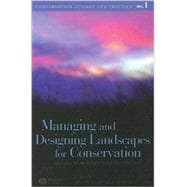
What is included with this book?
Richard Hobbs is an Australian Professorial Fellow in the School of Environmental Science at Murdoch University in Perth, Australia. He has broad interests spanning restoration ecology, conservation biology, landscape ecology and vegetation management. He has published 17 books and 266 scientific articles in these areas of research and is a Fellow of the Australian Academy of Science.
| Foreword: Landscapes in Peril | p. xi |
| Introduction | p. 1 |
| Classification of Landscapes and Terminology | p. 7 |
| The Whole Elephant: Classification and Terminology as Tools for Achieving Generality in Landscape Ecology | p. 9 |
| Enacting Landscape Design: from Specific Cases to General Principles | p. 22 |
| Landscape Models for Use in Studies of Landscape Change and Habitat Fragmentation | p. 35 |
| Synthesis: Landscape Classification | p. 49 |
| Habitat, Habitat Loss and Patch Sizes | p. 53 |
| Remnant Geometry, Landscape Morphology, and Principles and Procedures for Landscape Design | p. 55 |
| Estimating Minimum Habitat for Population Persistence | p. 64 |
| Habitat and Landscape Design: Concepts, Constraints and Opportunities | p. 81 |
| Synthesis: Habitat, Habitat Loss and Patch Sizes | p. 96 |
| Structure, Degradation and Condition | p. 99 |
| Nature's Infinite Variety: Conservation Choice and Management for Dynamic Ecological Systems | p. 101 |
| The Diverse Impacts of Grazing, Fire and Weeds: How Ecological Theory Can Inform Conservation Management | p. 111 |
| Forest Landscape Structure, Degradation and Condition: Some Commentary and Fundamental Principles | p. 131 |
| Synthesis: Structure, Degradation and Condition | p. 146 |
| Edge Effects | p. 149 |
| Incorporating Edge Effects into Landscape Design and Management | p. 151 |
| Edge Effects | p. 165 |
| Edges: Where Landscape Elements Meet | p. 179 |
| Synthesis: Edge Effects | p. 195 |
| Total Vegetation Cover, Pattern, Patch Content | p. 199 |
| Emergent Properties of Land Mosaics: Implications for Land Management and Biodiversity Conservation | p. 201 |
| Assessing the Biodiversity Value of Stands and Patches in a Landscape Context | p. 215 |
| Avoiding Irreversible Change: Considerations for Vegetation Cover, Vegetation Structure and Species Composition | p. 229 |
| Synthesis: Total Vegetation Cover, Pattern and Patch Content | p. 245 |
| Connectivity, Corridors, Stepping Stones | p. 249 |
| Corridors, Connectivity and Biological Conservation | p. 251 |
| Focal Species for Determining Connectivity Requirements in Conservation Planning | p. 263 |
| Connectivity, Corridors and Stepping Stones | p. 280 |
| Synthesis: Corridors, Connectivity and Stepping Stones | p. 290 |
| Individual Species Management - Threatened Taxa and Invasive Species | p. 293 |
| Individual Species Management: Threatened Taxa and Invasive Species | p. 295 |
| Managing Landscapes for Vulnerable, Invasive and Disease Species | p. 311 |
| Tools for Conserving Managing Individual Plant Species in Dynamic Landscapes | p. 330 |
| Synthesis: Individual Species Management - Threatened Taxa and Invasive Species | p. 343 |
| Ecosystems and Ecosystem Processes | p. 347 |
| Ecosystems, Ecosystem Processes and Global Change: Implications for Landscape Design | p. 349 |
| The Costs of Losing and of Restoring Ecosystem Services | p. 365 |
| Managing Disturbance Across Scales: An Essential Consideration for Landscape Management and Design | p. 376 |
| Synthesis: Ecosystems and Ecosystem Processes | p. 390 |
| Disturbance, Resilience and Recovery | p. 393 |
| Disturbance, Resilience and Recovery: A Resilience Perspective on Landscape Dynamics | p. 395 |
| Core Principles for Using Natural Disturbance Regimes to Inform Landscape Management | p. 408 |
| Synthesis: Disturbance, Resilience and Recovery | p. 423 |
| Aquatic Ecosystems and Integrity | p. 427 |
| Principles for Conserving Wetlands in Managed Landscapes | p. 429 |
| Flowing Waters in the Landscape | p. 445 |
| Water in the Landscape: The Coupling of Aquatic Ecosystems and their Catchments | p. 458 |
| Synthesis: Aquatic Ecosystems and Integrity | p. 473 |
| Bringing It All Together | p. 477 |
| Does Conservation Need Landscape Ecology? A Perspective from Both Sides of the Divide | p. 479 |
| What Are We Conserving? Establishing Multiscale Conservation Goals and Objectives in the Face of Global Threats | p. 494 |
| Goals, Targets and Priorities for Landscape-Scale Restoration | p. 511 |
| A Contribution to the Development of a Conceptual Framework for Landscape Management: A Landscape State and Transition Model | p. 527 |
| Principles of Landscape Design that Emerge from a Formal Problem-Solving Approach | p. 546 |
| From Perspectives to Principles: Where to From Here? | p. 561 |
| Index | p. 569 |
| Table of Contents provided by Ingram. All Rights Reserved. |
The New copy of this book will include any supplemental materials advertised. Please check the title of the book to determine if it should include any access cards, study guides, lab manuals, CDs, etc.
The Used, Rental and eBook copies of this book are not guaranteed to include any supplemental materials. Typically, only the book itself is included. This is true even if the title states it includes any access cards, study guides, lab manuals, CDs, etc.